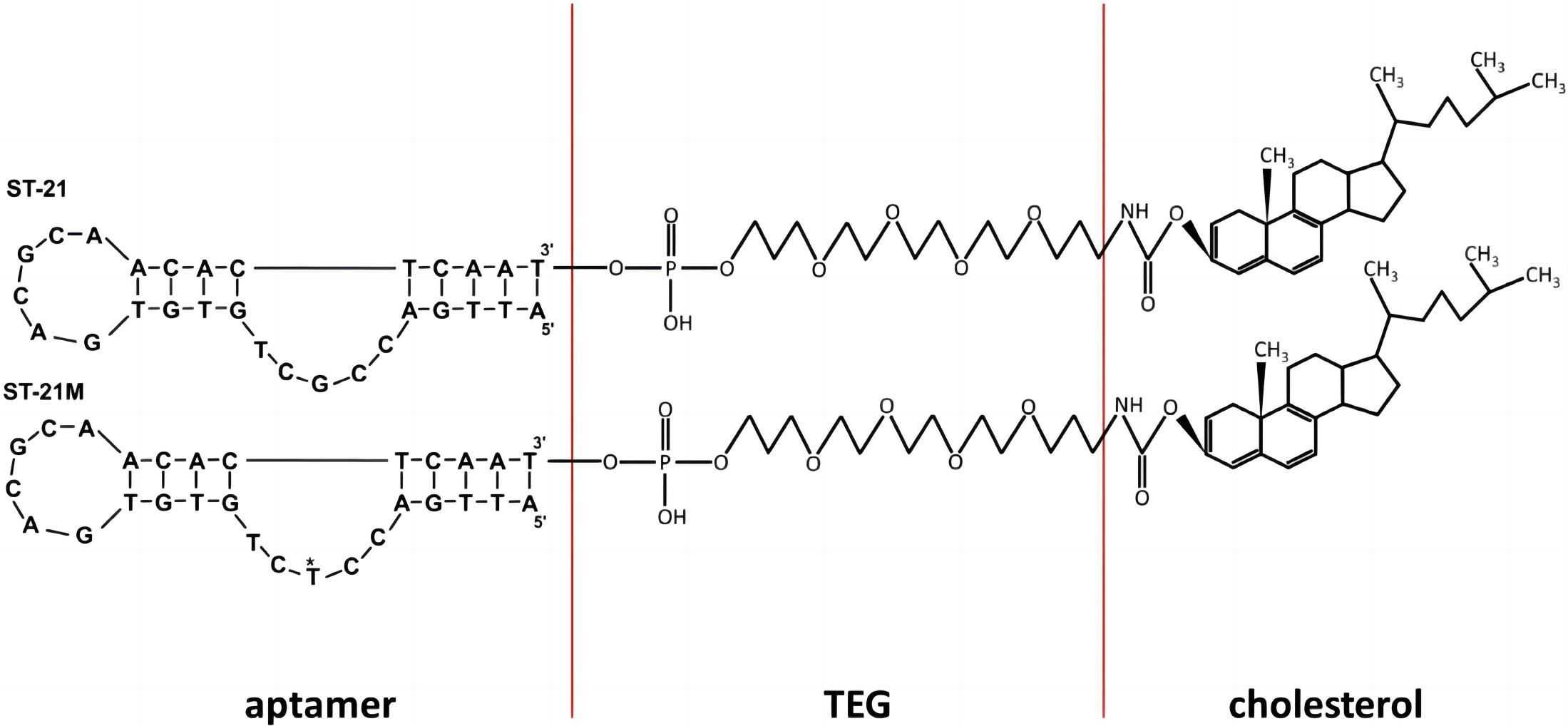Background of Aptamer-Cholesterol Conjugates
The aptamer is a small oligonucleotide (or peptide) fragment with a unique spatial structure that can specifically bind to the targets. In recent years, therapeutic aptamers have been widely researched and applied, as attractive alternatives to antibodies, due to its superior features. In contrast to antibodies, aptamers have multiple advantages, such as:
-
High stability: the three-dimensional structures are not easy to deform at high temperature;
-
Low immunogenicity: oligonucleotide fragments are low-immunogenic and low-toxic molecules;
-
High penetrability: the small aptamers usually consist of 30-80 nucleotides, and are more easily penetrate tissue, even cells, to reach specific targets;
-
Variety of target: aptamers can be developed to bind to a wide range of molecules, including common antigens, drugs viral particles, even those small molecules, non-immunogenic targets, and toxins that can’t elicit an immune response.
However, even with multiple superiorities, the efficiency of aptamers is limited by small molecule and small size, which leads to rapid excretion and short half-life. Thus, aptamers conjugates are developed to overcome the efficiency limitations. Aptamers can be conjugated with a wide range of molecules, such as drugs, aptamer-antibody conjugates, aptamer-nanoparticles conjugates, among which aptamer-cholesterol conjugates are produced by tagging the cholesterol to the 5’-end of the aptamer.
 Fig. 1 Structures of the aptamer-cholesterol conjugate.1, 2
Fig. 1 Structures of the aptamer-cholesterol conjugate.1, 2
Application of Aptamer-Cholesterol Conjugates
Dated back to 1991, Smidt et al. found that aptamer-cholesterol conjugate formed by linking cholesterol to the 5’-end of a 16-mer oligonucleotide with a 32P phosphate spacer had a longer half time in plasma compared with the unmodified aptamer. And the aptamer-cholesterol conjugate could rapidly be associated with plasma lipoproteins (both high-density lipoproteins and low-density lipoproteins) forming a stable complex against the degradation by serum nucleases.
Another investigation conducted by Lee showed that conjugation of a 2’-F modified 29-nucleotide RNA aptamer with a cholesterol moiety at 5’-end also significantly remarkably prolonged the plasma half-life through association with plasma lipoproteins. More importantly, this aptamer-cholesterol conjugate could be efficiently uptaken and entered into the hepatic cell, and inhibited RNA replication of the Hepatitis C virus, without causing any alteration in gene expression profiling in vitro. These studies indicated that aptamer-cholesterol conjugates are considerable methods for the half time improvement of aptamer, even effective choices for anti-Hepatitis C virus infections.
Advantages of Our Aptamer-Cholesterol Conjugates Development Services
Over the past years, specialists in Creative Biolabs have developed a highly specialized platform as well as protocols for aptamer conjugate development to meet our client's requirements. We proudly offer global customers the most tailored aptamer-cholesterol conjugate development services with advantages of:
-
Fully customized: no matter aptamer and cholesterol types or partial/one-stop service is all based on your specific needs
-
High reproducibility: standard experiment operation, quality control test, and service process ensure the reproducibility of the data
-
Abundant experience: we have completed multiple aptamer development projects, accumulating rich experience
If you have any questions or demands, please do not hesitate to contact us directly. Our seasoned scientists will reply to you with a tailored solution as soon as possible.
References
-
Sung, Tzu-Cheng, et al. "A replaceable liposomal aptamer for the ultrasensitive and rapid detection of biotin." Scientific reports 6.1 (2016): 21369.
-
under Open Access license CC BY 4.0, without modification
Related Product
Questions & Answer
A: In the design of aptamer-cholesterol conjugates, factors such as the stability of the conjugate, the efficiency of cholesterol binding, and the potential for cellular uptake should be considered. The choice of linker molecule and the position of cholesterol attachment on the aptamer can also impact the performance of the conjugate.
A: One challenge in the development of aptamer-cholesterol conjugates is ensuring the stability and integrity of the conjugate during synthesis and storage. Another challenge is optimizing the binding affinity and specificity of the aptamer for cholesterol while maintaining its targeting properties.
A: Aptamer-cholesterol conjugates have potential applications in drug delivery, where they can selectively deliver cholesterol or cholesterol-modified drugs to specific cells or tissues. They can also be used in imaging techniques to detect cholesterol-rich regions or in diagnostic assays for cholesterol detection.
For Research Use Only.
Related Sections:

 Fig. 1 Structures of the aptamer-cholesterol conjugate.1, 2
Fig. 1 Structures of the aptamer-cholesterol conjugate.1, 2